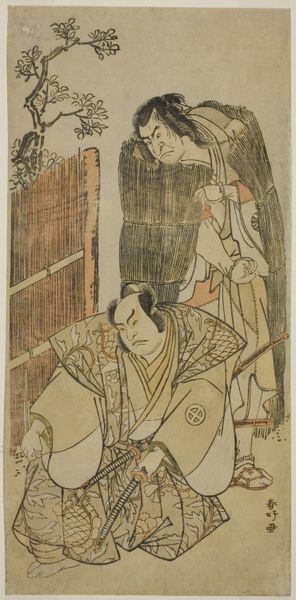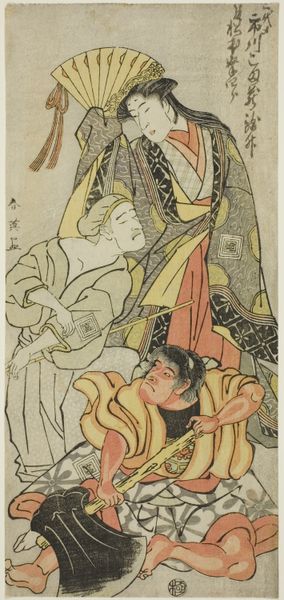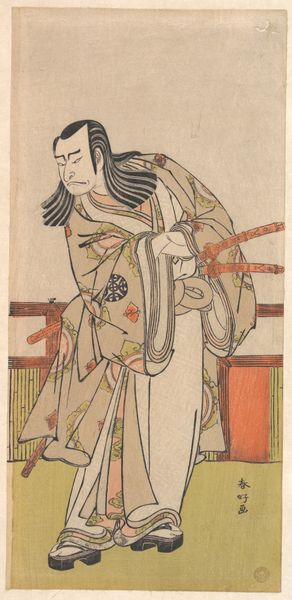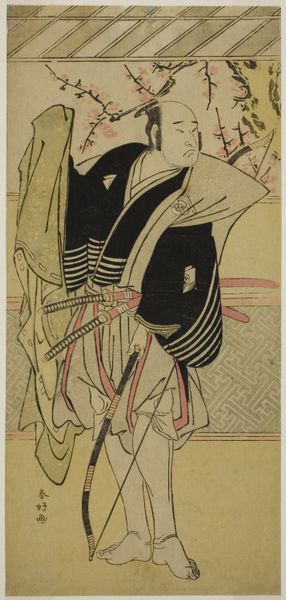
Twee opzij kijkende courtisanes onder een bloesemende kersenboom 1779 - 1783
0:00
0:00
print, woodblock-print
#
portrait
#
ink drawing
# print
#
asian-art
#
ukiyo-e
#
figuration
#
woodblock-print
#
genre-painting
Dimensions: height 675 mm, width 126 mm
Copyright: Rijks Museum: Open Domain
Curator: Here at the Rijksmuseum, we're fortunate to have this striking woodblock print by Torii Kiyonaga, made between 1779 and 1783. The title translates to "Two Courtesans Looking Aside Under a Blossoming Cherry Tree." Editor: My first impression is one of gentle melancholy. There's a poised stillness about the figures, despite them both looking slightly away, their gazes directed elsewhere. It's a composition layered with a sense of subtle yearning, and maybe even world-weariness. Curator: Yes, the figures definitely convey an air of detachment. Kiyonaga, as a master of ukiyo-e, excelled in depicting the elegant fashions and social milieu of Edo period Japan. He likely inherited an acute understanding of woodblock printing as a commercial art; consider how his meticulous line work emphasizes the textile patterns of the women’s garments and also the blooming tree as material and design. Editor: The cherry blossom is, of course, laden with symbolic meaning in Japanese culture. Beyond its beauty, it speaks of transience, a bittersweet acceptance of life's ephemeral nature. The courtesans themselves embody this, existing in a liminal social space, both admired and constrained. Curator: Exactly. The creation and dissemination of prints such as these served a critical function within that commercial ecosystem, which served a spectrum of the Edo society that both supported, fetishized, and looked down on sex workers as both outside of society, but totally bound up in the capitalistic engine of it. There is such a fascinating tension built up in what the material practices of the production reveal to us about the people who would consume these things, and in what social context. Editor: The angle is crucial. Notice their upward glances are nearly identical, hinting perhaps that they share something, some experience. We have these silent connections that underscore the social fabric here represented; or perhaps even a shared resignation, framed as it is beneath the weight of those transient cherry blossoms. Curator: Yes, Kiyonaga’s craft draws our attention not just to who these women *were* materially— but *are,* iconographically speaking: women defined by, adorned by, and employed as beautiful aestheticized surfaces, even now. It's all subtly woven together. Editor: I find that incredibly thought-provoking. This print really does encapsulate the beautiful and ephemeral, both in its subject matter and in the enduring legacy of its imagery. Curator: Absolutely. And from a materialist perspective, it shows the depth and breadth of understanding that Kiyonaga must have had to create and print these pieces with a clear view on his potential audiences. The tension alone creates intrigue and desire for ownership.
Comments
No comments
Be the first to comment and join the conversation on the ultimate creative platform.













